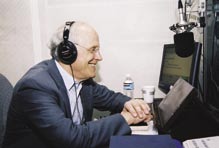
Walter Kohn and David Gross, respectively the founding and the current directors of the KITP, and winners of Nobel Prizes, joined two other UCSB Nobel-Prize-winning physicists, Herbert Kroemer and Alan Heeger, to commemorate this “Year of Physics” by reading Einstein’s only popular science book, The Evolution of Physics: The Growth of Ideas From Early Concepts to Relativity and Quanta, for Recording for the Blind and Dyslexic.
The Year of Physics celebrates the 100th anniversary of Einstein’s annus mirabilis of 1905 — the year he published three landmark papers (each in a different area of physics) that changed the course of physics forever, and radically altered human conceptions of reality.
Einstein himself received the Nobel Prize in Physics in 1921 for insights into the “photoelectric” effect reported in his first paper of that most remarkable year.
Photoelectric effect
He deduced that light itself must be considered as consisting of quanta of energy, or particles (photons), with energy determined by the frequency of light. Having proposed, for the first time, the existence of a new particle of light, he used that hypothesis to explain and to make quantitative predictions about the so-called photoelectric effect.
It had been observed that when high intensity light is shown on metal, electrons are emitted. That phenomenon was not understood nor could it be understood within the classical theory of electromagnetism. Einstein used the hypothesis of light as quanta of energy to predict the energies of the emitted electrons. His predictions were later confirmed by experiment.
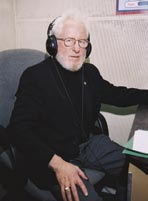
Einstein himself believed this first to be the most revolutionary of his three big papers of 1905 because it pushed forward the then embryonic development of quantum theory, the basis for today’s high technology.
Brownian motion
The second paper addressed the theory of Brownian motion, originally observed by the botanist Robert Brown 70 years earlier, in the apparently random motion of pollens suspended in a liquid.
Some scientists thought that the pollen particles were being jiggled by the liquid’s atoms and molecules.
Realizing that they were right, Einstein, a master of statistical mechanics gave, for the first time a mathematical treatment of the random motion of the pollen grains. Assuming random hits of the pollen grains by atoms in the liquid, he calculated on average what such motion would look like (i.e., a drunken walk).
He thereby provided a direct quantitative way to test for the existence of atoms that could not be seen, but could be sensed in the erratic motion of pollen grains. His quantitative theory could be tested. Experimental verification 10 to 15 years later of his predictions confirmed the atomic hypothesis. Heretofore, atoms had been useful “devices” for calculating the properties of matter, but some people had not really believed atoms existed because they could not as yet be seen.
Special relativity
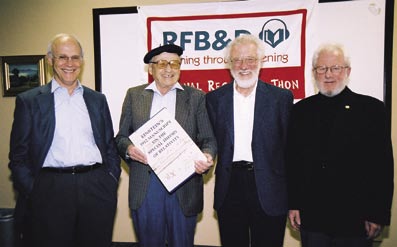 UCSB science Nobel laureates and physicists David Gross (l), Walter Kohn, Herbert Kroemer, and Alan Heeger at the Goleta studio of Recording for the Blind and Dyslexic.
Photos by Nell Campbell.
UCSB science Nobel laureates and physicists David Gross (l), Walter Kohn, Herbert Kroemer, and Alan Heeger at the Goleta studio of Recording for the Blind and Dyslexic.
Photos by Nell Campbell.
The third paper—the one for which Einstein is most famous — presents the theory of special relativity. Einstein realized that the theory of electromagnetism, as set forth in Maxwell’s equations, required a modification of Newton’s theory of mechanics, which took time to be absolute.
Before 1905, people had postulated the existence of “ether,” which was thought to fill the universe, and in which electromagnetic waves propagated. Einstein, who said “no” to the existence of ether, considered instead assumptions about how space and time are defined and measured.
Assuming the constancy of the speed of light (which is a consequence of Maxwell’s equations), Einstein showed by simple and beautiful arguments that in different moving frames, space and time can appear different — i.e., particular lengths can be contracted and time can be dilated in moving frames as observed by an observer in another frame.
E=mc2
In a follow-up paper, Einstein went on to build on the theory of special relativity to show that mass and energy are equivalent, and to derive the famous equation E=mc2. He argued that anything that has energy has inertial mass, so mass and energy are the same. This follow-up paper says, in effect, that if the notions of space and time change, then so do the notions of energy and momentum.
The fifth and final paper of 1905 used the theory of Brownian motion (advanced in the second paper) to measure the size of molecules and atoms, and thereby provided predictions for the experimental testing alluded to above.
Having remarked that it is not unusual for a theoretical physicist to publish five papers in one year, Gross said, “It is, however, clearly pretty unusual that three such spectacular contributions would come from an unknown patent clerk all in one year. And that’s why physicists are using this occasion to celebrate physics and Einstein.”
Einstein co-authored his one book-length attempt at popular science writing with his friend and fellow physicist and refugee, Leopold Infeld. The book was published in 1938 by Simon and Schuster. Einstein was then at the Institute for Advanced Study in Princeton, where Infeld visited during the collaboration.
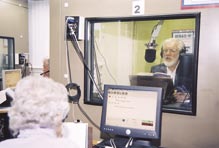
The book consists of four chapters — one read by each of the UCSB Nobel Prize winners for recording: “The Rise of the Mechanical View,” “The Decline of the Mechanical View,” “Field, Relativity,” and “Quanta.”
Einstein’s ‘idealized reader’
As Einstein and Infeld intimate in the “Preface,” the text is noteworthy for its lack of equations: “Whilst writing the book, we had long discussions as to the characteristics of our idealized reader, and worried a good deal about him. We had him making up for a complete lack of any concrete knowledge of physics and mathematics by quite a great number of virtues. We found him interested in physical and philosophical ideas, and we were forced to admire the patience with which he struggled through the less interesting and more difficult passages. He knew that a scientific book, even though popular, must not be read in the same way as a novel.”
A disproportionate number of the books that Recording for the Blind and Dyslexic makes audible concern scientific or technical subjects that do not attract the wider audience and therefore profitable market of novels and commercial non-fiction works.
Several works by Einstein were considered, but his popular book was selected on the recommendation of Gross, who received it at age 13 as a present from Infeld’s cousin, and who was “turned onto physics” from reading it.
Though all readers were physicists, Kohn, a physics professor, won the 1998 chemistry prize; Kroemer, an engineering professor, won the 2000 physics prize; Heeger, a physics professor, won the 2000 chemistry prize; and Gross, a physics professor, won the 2004 physics prize.
Celebrations internationally
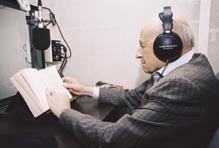
Gross, whose Nobel Prize was awarded for explaining the strong force, and whose later research focuses on string theory and the attempt to unify all four forces, has given a talk on “Einstein and the Search for Unification” at 2005 commemorative conferences hosted by the Einstein Forum in Berlin, by the Eidgenössische Technische Hochscule (ETH) in Zurich, by the Israeli Academy of Sciences in Jerusalem, by the Skirball Cultural Center in Los Angeles, by the National Academy of Sciences in Washington, D.C., and by Warsaw University.
The talk features a retrospective of Einstein’s failed search for unification which is, however, vindicated by the contemporary quest for unification of all the four forces of nature, including gravity.
